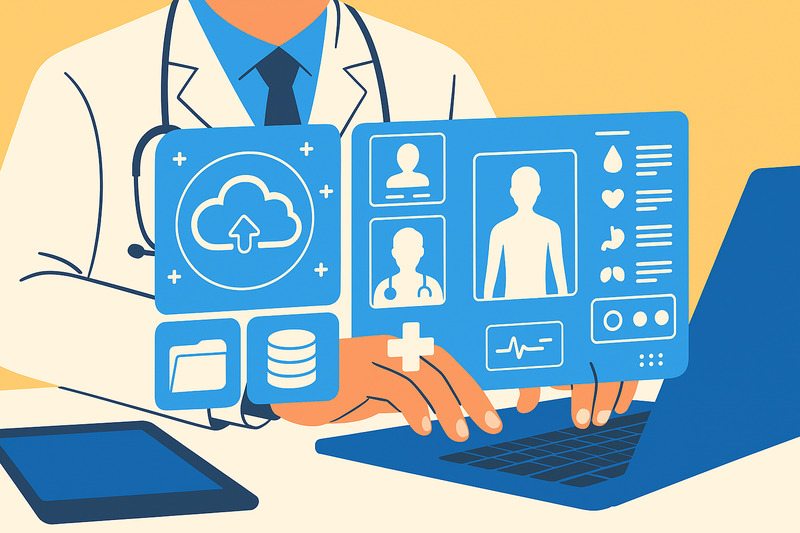
Healthcare is changing quickly. Patients want better experiences. Providers need systems that work better. This is where medical computer software comes in. It makes delivery care smarter, faster and safer.
It’s not just about making paperless forms; it’s also about using smart tools to cut down on mistakes, speed up processes and improve patient outcomes.
This software takes care of boring tasks for healthcare workers, like keeping track of appointments and patient records, making prescriptions easier and billing. This lets them focus on what matters most: taking care of patients.
This article talks about what medical computer software is, why it’s important and how it changes the way healthcare is done around the world.
Table of Contents
ToggleWhat Is Medical Computer Software?
Medical computer software is just digital programs that healthcare providers use to manage clinical, administrative and financial tasks. These tools are the backbone of modern, efficient healthcare delivery, whether it’s a hospital, a solo clinic or a telemedicine startup.
Modern medical software programs do more than keep records. They help people make better decisions, speed up processes and keep up with changing rules.
It’s the digital backbone of modern care delivery.
Some common parts are:
| Feature | Description |
| Electronic Health Records (EHR) | Centralize patient history, treatments and lab results |
| Scheduling Systems | Manage appointments, reduce waiting times, avoid conflicts |
| Billing & Claims | Automate invoicing, insurance submissions and payments |
| Prescriptions | Send prescriptions directly to pharmacies via 2.5B e-prescriptions processed in 2023. |
| Clinical Decision Support | Algorithms to assist diagnosis and treatment choices |
Each part helps make things more accurate, cut down on mistakes made by hand and make workflows more efficient.
Why Healthcare Providers Are Switching to Digital Tools
In today’s fast-paced healthcare world, old-fashioned paper records and manual processes don’t work anymore. They make things take longer, create more mistakes and waste time that could be better spent.
Healthcare providers use healthcare software because:
- They need to serve more patients quickly
- They must follow stricter legal and regulatory rules
- Patients expect modern services like online booking and telehealth
- They need data-driven insights to improve care quality and keep costs down
FACT: U.S. administrative outlays are 8% spending ($800 per person) a key target for digitization.
In this digital age, using medical computer software isn’t a luxury; it’s necessary for survival and growth.
Key Features of Modern Medical Software Programs
The best medical software programs put usability, security and a wide range of features at the top of their lists:
1. User-Friendly Interface
Both clinicians and administrative staff should be able to learn and use the software easily.
2. Mobile Access
Doctors and nurses need to be able to see records, add to notes and manage their schedules while they are on the go.
3. Integrated Modules
Billing, scheduling and clinical functions all work together without any problems, so there is no need to do the same work twice.
4. Telehealth Capabilities
Built-in video and messaging support growing use (Medicare 12.7% telehealth in Q4 2023).
5. Data Encryption & Security
Encryption, access controls and following HIPAA or GDPR rules keep patient data safe and lower the risk of legal problems.
TIP: Choose software that lets you customize dashboards and analytics to keep track of key performance indicators.
Benefits of Using Healthcare Software in Clinics and Hospitals
Using medical computer software improves both the business and the clinical side of things.
Here’s how it makes a difference:
1. Improved Efficiency
Things that used to take hours now only take minutes, which cuts down on wait times and increases capacity.
2. Fewer Errors
Automated validation cuts down on mistakes in billing and prescriptions.
3. Better Patient Experience
Broad patient portal access lets people view records, message care teams and stay engaged.
4. Faster Decision-Making
Having lab results and records right away speeds up diagnosis and treatment.
5. Compliance Made Easy
Automation cuts down on costs and lets clinics see more patients without hiring more staff.
Real-World Use Cases of Healthcare Applications
Different healthcare settings benefit in other ways from customized healthcare applications:
1. Small Clinics
Use one dashboard to keep track of appointments patient information and follow-ups.
2. Hospitals
Deploy comprehensive hospital information systems (HIS) to connect departments, labs, and pharmacies. It speeds up internal coordination and improves emergency care.
3. Diagnostic Labs
Keep track of tests, send reports right away and let staff know when results are urgent.
4. Telemedicine Startups
One app lets you have full virtual consultations, get prescriptions and pay your bills.
5. Mental Health Practices
Use safe online tools for therapy, taking notes and keeping track of your progress.
TIP: Multi-location practices benefit when vendors participate in TEFCA QHINs for cross-network exchange.
Choosing the Right Medical Computer Software for Your Practice
There are a lot of choices for medical computer software, so you need to think carefully about which one to choose:
| Factor | What to Check |
| Practice Size | Suitable for solo, group, or hospital-scale use? |
| Core Features | Must include EHR, billing, scheduling, prescriptions and security. |
| Integration | Works with labs, pharmacies and third-party tools? |
| Ease of Use | Intuitive for clinical and administrative users? |
| Support | Includes training and 24/7 assistance. |
| Compliance | Meets HIPAA, GDPR and ISO standards? |
A good solution lowers burnout increases productivity and improves patient care.
Data Security and Compliance in Medical Software
Keeping sensitive patient information safe is very important. Any medical software program should have the following features:
- Encryption while in transit and at rest
- Role-based access control that limits access to sensitive information
- Audit logs that keep track of who accesses data
- Regular backups and disaster recovery
Not following rules like HIPAA and GDPR could lead to big fines and damage to your reputation.
FACT: The average healthcare data breach costs almost $11 million, which shows how important it is to have strong security in healthcare software.
Future Trends in Medical Computer Software
The software used in healthcare is changing quickly. Some of the trends that will shape its future are:
1. Artificial Intelligence (AI)
Figuring out what’s wrong with people, looking at pictures and guessing what will happen next.
2. Predictive Analytics
Finding high-risk patients early on to keep them from going to the hospital.
3. Cloud-Based Platforms
Can grow, is cheap and can be accessed from anywhere.
4. Blockchain Security
A safe and open way to share data and manage patient consent.
5. Virtual Health Assistants
Putting money into medical computer software with these new features can help your healthcare business stay up to date.
Final Thoughts
Healthcare today needs smarter tools. Healthcare software has become an important part of safe, efficient and patient-centered care. Digital solutions make work easier, save money and make the patient’s experience better in everything from small clinics to big hospitals.
It’s not just a tech choice to pick the right software; it’s also a smart business move. Begin by looking at what you need right now, then plan and finally choose tools that fit with how you work. You will be able to manage your resources better while also improving the quality of care.
In the end, healthcare is about people. The right medical computer software lets providers focus on their patients while the system takes care of everything else.


